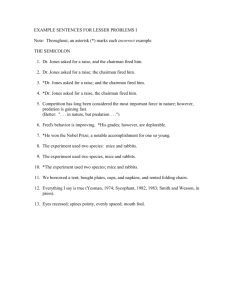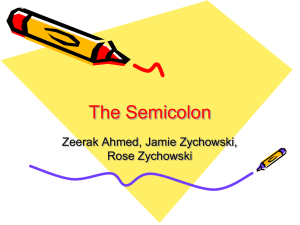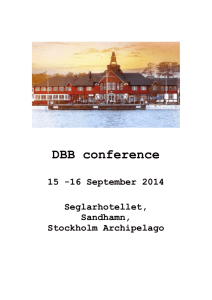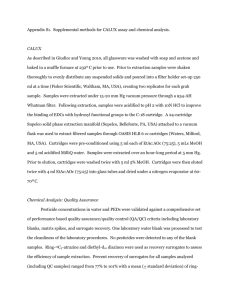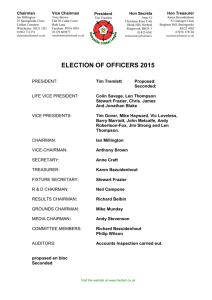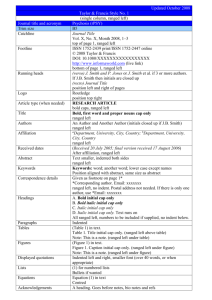3a Lesser problems I examples
advertisement
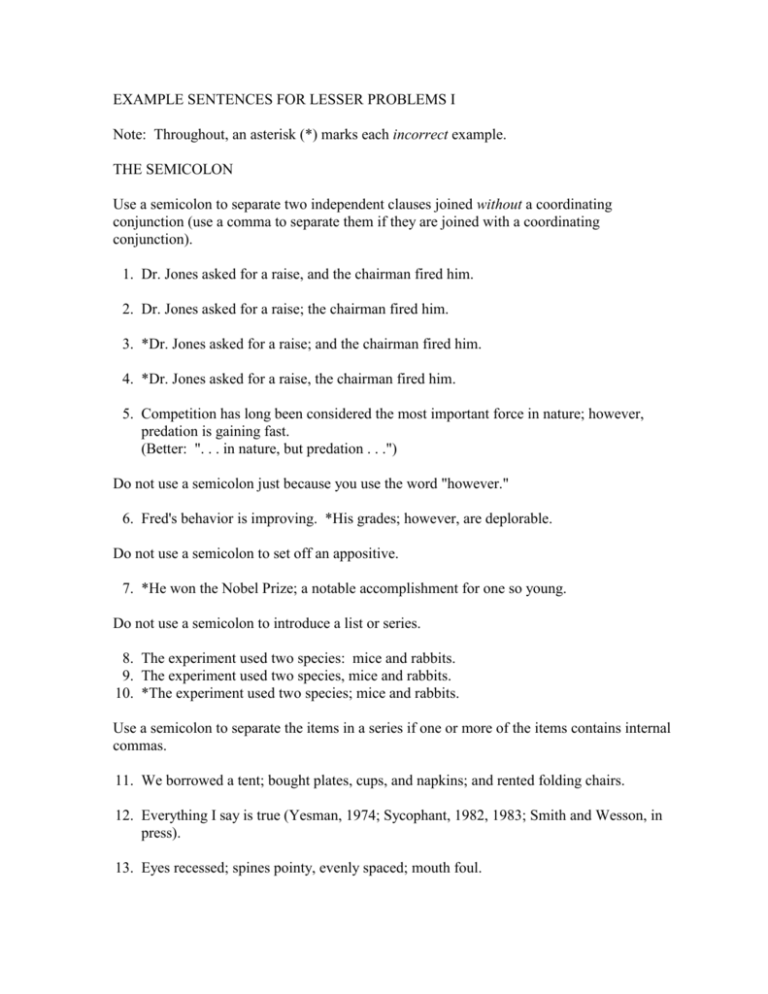
EXAMPLE SENTENCES FOR LESSER PROBLEMS I Note: Throughout, an asterisk (*) marks each incorrect example. THE SEMICOLON Use a semicolon to separate two independent clauses joined without a coordinating conjunction (use a comma to separate them if they are joined with a coordinating conjunction). 1. Dr. Jones asked for a raise, and the chairman fired him. 2. Dr. Jones asked for a raise; the chairman fired him. 3. *Dr. Jones asked for a raise; and the chairman fired him. 4. *Dr. Jones asked for a raise, the chairman fired him. 5. Competition has long been considered the most important force in nature; however, predation is gaining fast. (Better: ". . . in nature, but predation . . .") Do not use a semicolon just because you use the word "however." 6. Fred's behavior is improving. *His grades; however, are deplorable. Do not use a semicolon to set off an appositive. 7. *He won the Nobel Prize; a notable accomplishment for one so young. Do not use a semicolon to introduce a list or series. 8. The experiment used two species: mice and rabbits. 9. The experiment used two species, mice and rabbits. 10. *The experiment used two species; mice and rabbits. Use a semicolon to separate the items in a series if one or more of the items contains internal commas. 11. We borrowed a tent; bought plates, cups, and napkins; and rented folding chairs. 12. Everything I say is true (Yesman, 1974; Sycophant, 1982, 1983; Smith and Wesson, in press). 13. Eyes recessed; spines pointy, evenly spaced; mouth foul. 2 "NOR" Use "nor" only (a) with "neither" . . . 14. Neither brilliance nor diligence guarantees success in graduate school. 15. The experiment succeeded in detecting neither the phenomenon under study nor the presence of the experimental organism. 16. The experiment did not succeed in detecting the phenomenon under study or (*nor) the presence of the experimental organism. 17. I have never liked skiing or (*nor) bobsledding. 18. No eating, drinking, smoking, or (*nor) using tobacco is allowed in the library. . . . or (b) to negate a second (or subsequent) negated clause (remember to invert the clause negated by "nor"). 19. The investigator left no possibility unstudied; his budgetary management could not be faulted either. 20. The investigator left no possibility unstudied, nor could his budgetary management be faulted. 21. The professor cannot make himself understood, and he can't keep the class under control. 22. The professor cannot make himself understood, nor can he keep the class under control. 3 REDUNDANT USE OF "BOTH" Use "both" to emphasize the conjoined nature of items joined by "and." 23. Dr. Travis and Dr. Simberloff are ecologists. 24. Both Dr. Travis and Dr. Simberloff are ecologists. 25. Dr. Travis and Dr. Simberloff are both ecologists. Use it only with "and." 26. *Both Dr. Travis as well as Dr. Simberloff are ecologists. 27. *A biologist studies both botany in addition to zoology. Do not use it when it is redundant—that is, when the relationship being expressed is inherently reciprocal (i.e., if, by definition, the relationship requires two participants). 28. Mack and Jack are similar (to each other). 29. *Both Mack and Jack are similar (to each other). 30. Both Mack and Jack are similar to Zack. 31. *This study compares both the Apalachicola and the Blackwater. 32. *The Apalachicola and the Blackwater are both located in north Florida, and this study compares both. 33. The Apalachicola and the Blackwater are both located in north Florida, and this study compares the two. 34. The Apalachicola and the Blackwater are both located in north Florida, and this study compares both to the Chipola. 35. *Both Pagurus pollicaris and P. impressus were tested separately in this experiment. (grammatical on the reading that individuals of the two species were tested singly rather than in groups) Be careful that you actually mean "both." 36. The cat and the dog were recaptured and a leash attached to both. 37. The cat and the dog were recaptured and a leash attached to each. 4 "LIKE" AND "AS" "Like" is a preposition and can therefore be followed only by a noun and the noun's modifiers. "As" is subordinating conjunction and can be followed only by clauses or reduced clauses (but not by a lone noun and its modifiers). 38. Like most biologists, he gives frequent dinner parties. 39. *As most biologists, he gives frequent dinner parties. 40. *Like most biologists do, he gives frequent dinner parties. 41. As most biologists do, he gives frequent dinner parties. 42. Conflict rages among the faculty, as it does in many departments. 43. Conflict rages among the faculty, as in many departments. 44. As in many departments, conflict rages among the faculty. 45. *Like in many departments, conflict rages among the faculty. When "as" is used as a preposition, it expresses "identity" not "similarity." 46. As your chairman, I must insist on proper discipline in faculty meetings. 47. Like your chairman, I must insist on proper discipline in faculty meetings. 48. Fred is acting like a lawyer. 49. Fred is acting as a lawyer. 5 HYPHENATION Some words that are hyphenated lexically (that is, as part of their normal spelling). 50. one-up two-step (the dance) safe-conduct self-respect home-body Don't try to coin more such compounds. 51. *Markham, J. C. 1968. Notes on growth-patterns and shell-utilization of the hermit crab Pagurus bernhardus (L.). Ophelia 5:189–205. In American usage, most common prefixes are normally appended directly, without hyphens. 52. cointerintramicro- midprepostsub- 53. Some words formed with these prefixes midsummer interspecific subequal coauthor preempt intraarterial but semi-independent, non-English When a prefix is separated from its root, the hyphen is used to mark the missing root. 54. pre- and postdoctoral programs macro-, meio-, and microfauna When two words act together as a compound adjective (especially if one of them is a noun), and they precede the word they modify, they are joined with a hyphen. 55. Deep-sea animals are often blind. 6 56. Animals in the deep sea are often blind. 57. Collect a 1-ml water sample. 58. Collect 1 ml of water. 59. Leaf-miner density is highest in the summer. 60. Density of leaf miners is highest in the summer. 61. Density-vague phenomena are often encountered. 62. Investigators often encounter phenomena that are density vague. Modifiers should not be hyphenated to the words they modify. 63. *Markham, J. C. 1968. Notes on growth-patterns and shell-utilization of the hermit crab Pagurus bernhardus (L.). Ophelia 5:189–205. 64. *It was a very easily-broken promise. 65. *Fully-formed ideas rarely emerge suddenly. An exception is adverbs that do not end in "-ly." In cases where they might be mistaken for adjectives, they are hyphenated to the adjectives they modify, so that the reader can tell they do not modify the noun instead. 66. He's a well-known exhibitionist. 67. A fast-moving car hit the fire hydrant. 68. First- and second-stage larvae have no gastric mill. 7 DASHES N-dashes are used to indicate a range of values, . . . 69. The range of depth was 10–20 meters. I attended graduate school 1972–1977. Dr. Jones will be on sabbatical during the 2001–02 academic year. Robert Louis Stevenson (1850–1894); Isaac Stern (1920–) . . . but not after "between" or "from." 70. 71. 72. 73. *The depth ranged between 10-20 meters. The depth ranged between 10 and 20 meters. *The coverage ranged from 10-20%. The range of coverage was 10-20%. The range of coverage was narrow (or wide). 74. *The coverage ranged from 10-20%. *The coverage ranged from narrow (or wide). 75. *The depth ranged between 10-20 meters. *The depth ranged between narrow (or wide) meters. When two items are joined by a hyphen, but one or both of the items either already contains a hyphen or consists of more than one word, then an n-dash is used instead. 76. the New York–London flight during the post–Civil War period a quasi-public–quasi-private body M-dashes are used as separators or enclosers to set off material that interrupts the sentence. 77. This year's winter carnival—a stunning success—took place in December. It was an excellent winter carnival—a stunning success. A 2m-dash replaces missing letters within a word. 78. It's a d——n lie! Cut out the b——t. A 3m-dash replaces one or more missing words. 79. Jones 1953 ——— 1955 Smith 1926 ——— and Wesson 1975 8
